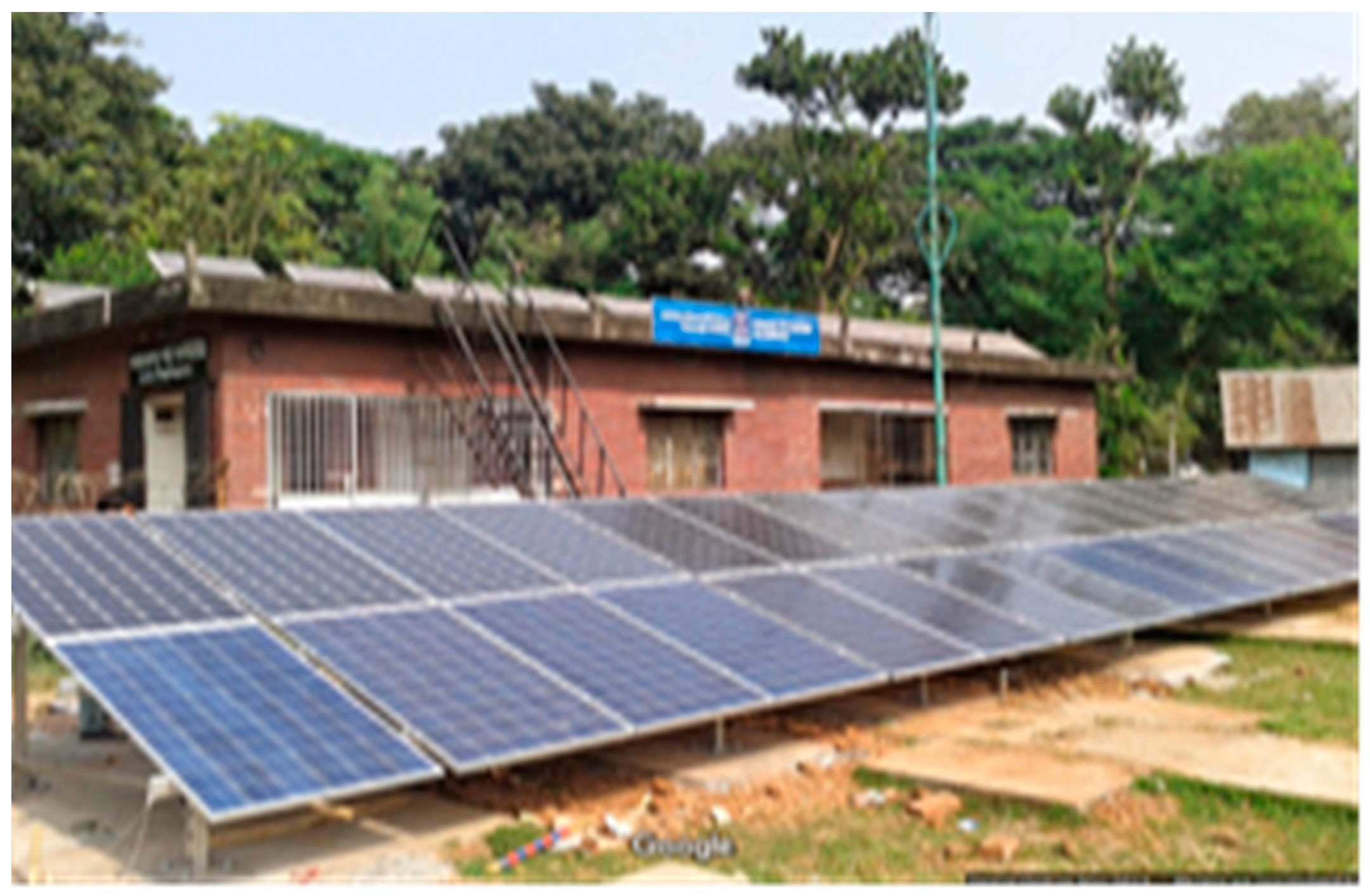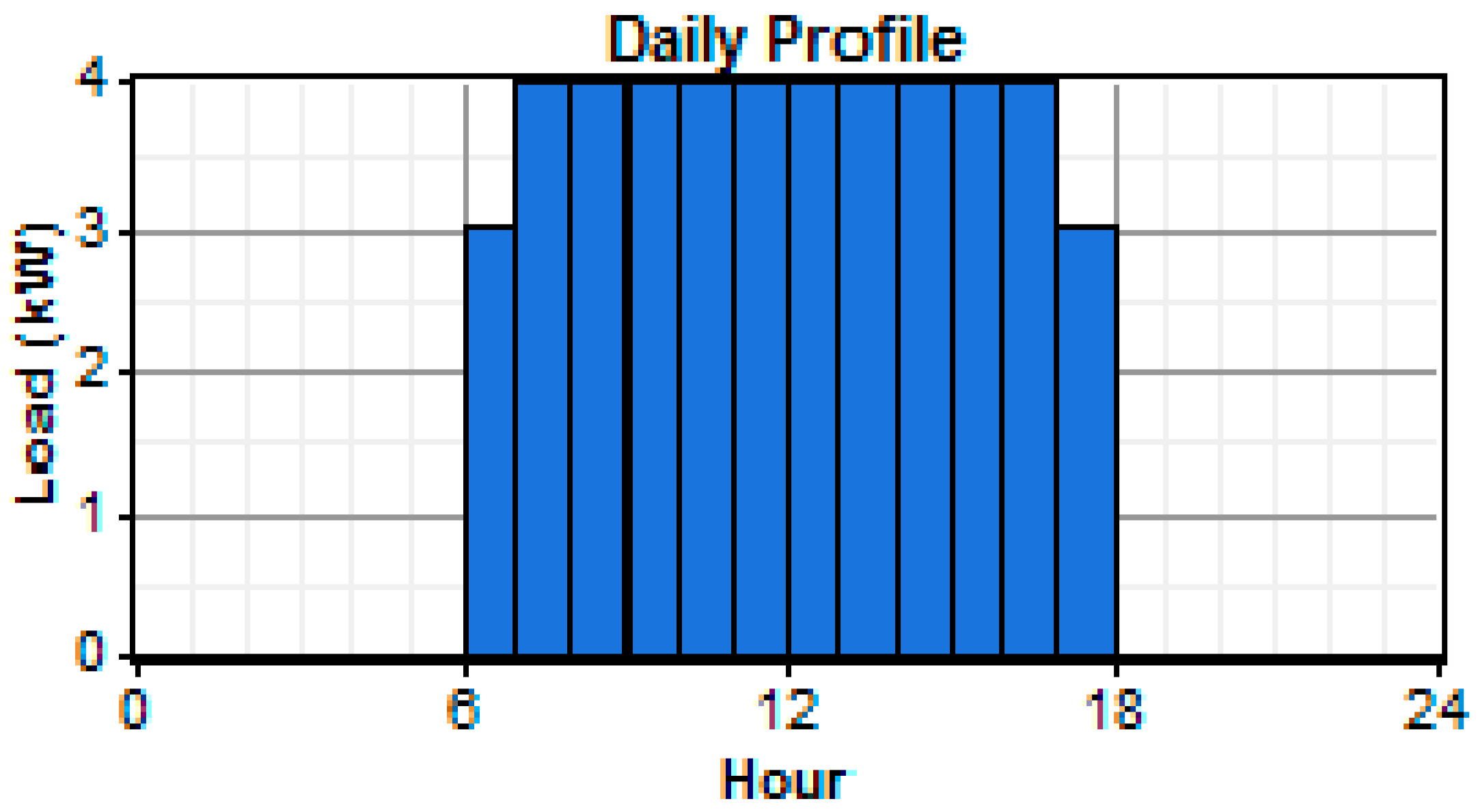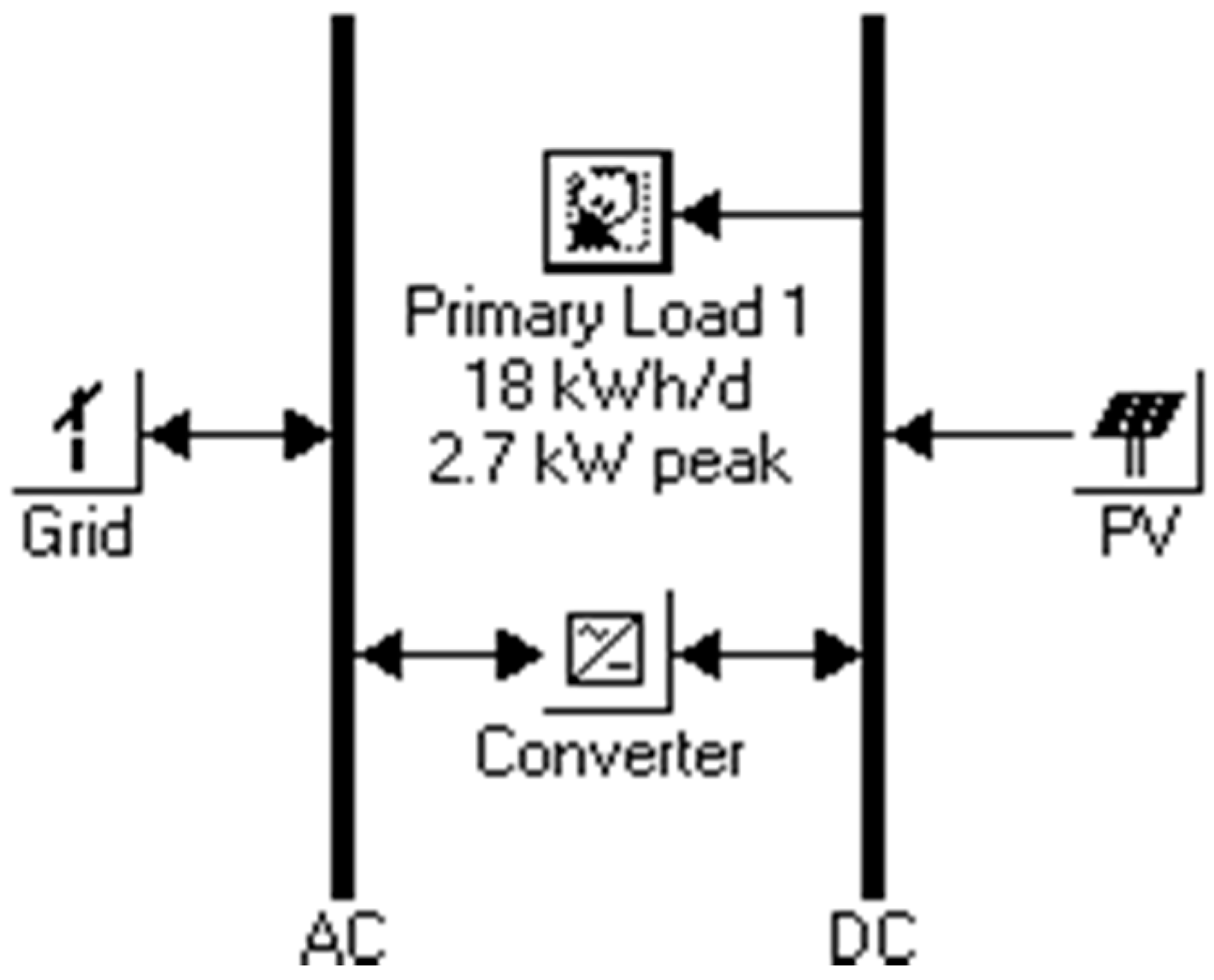Optimization of Solar Energy System for the Electric Vehicle at University Campus in Dhaka, Bangladesh
Abstract
1. Introduction
2. Existing Solar PV System Installed in Dhaka University Campus
3. Proposed Electric Buses for the University
4. Renewable Energy Sources, Load Profile, and System Design Using HOMER
4.1. Load Profile Based on Collected Data
4.2. Size Consideration of Solar Photovoltaic Array
4.3. Battery Size and Converter
4.4. Grid Connection to Microgrid System
5. Green Transportation Model, Simulation Results, and Discussion
6. Conclusions
Author Contributions
Funding
Conflicts of Interest
References
- Chowdhury, N.; Hossain, C.A.; Zishan, S.R.; Brenna, M.; Longo, M. Eco-Friendly Transportation System in Proposed Permanent Campus of American International University-Bangladesh. In Proceedings of the 6th International Conference on Clean Electrical Power (ICCEP), Santa Margherita Ligure, Italy, 27–29 June 2017; pp. 1–5. [Google Scholar]
- García-Olivares, A.; Solé, J.; Osychenko, O. Transportation in a 100% renewable energy system. Energy Convers. Manag. 2018, 158, 266–285. [Google Scholar] [CrossRef]
- Bangladesh Development Board. Annual Report (2016–2017). Available online: http://www.bpdb.gov.bd/download/annual_report/Annual%20Report%202016-17%20.pdf (accessed on 24 April 2018).
- Iodice, P.; Senatore, A. Atmospheric pollution from point and diffuse sources in a National Interest Priority Site located in Italy. Energy Environ. 2016, 27, 586–596. [Google Scholar] [CrossRef]
- Costagliola, M.A.; Prati, M.V.; Florio, S.; Scorletti, P.; Terna, D.; Iodice, P.; Buono, D.; Senatore, S. Performances and emissions of a 4-stroke motorcycle fuelled with ethanol/gasoline blends. Fuel 2016, 183, 470–477. [Google Scholar] [CrossRef]
- Iodice, P.; Langella, G.; Amoresano, A. Ethanol in gasoline fuel blends: Effect on fuel consumption and engine out emissions of SI engines in cold operating conditions. Appl. Thermal Eng. 2018, 130, 1081–1089. [Google Scholar] [CrossRef]
- Longo, M.; Yaici, W.; Zaninelli, D. “Team Play” between Renewable Energy Sources and Vehicle Fleet to Decrease Air Pollution. Sustainability 2016, 8, 27. [Google Scholar] [CrossRef]
- Ahiduzzaman, M.D.; Sadrul Islam, A.K.M. Greenhouse gas emission and renewable energy sources for sustainable development in Bangladesh. Renew. Sustain. Energy Rev. 2011, 15, 4659–4666. [Google Scholar] [CrossRef]
- Islam, M.D.T.; Shahir, S.A.; Iftakhar Uddin, T.M.; Saifullah, A.Z.A. Current energy scenario and future prospect of renewable energy in Bangladesh. Renew. Sustain. Energy Rev. 2014, 39, 1074–1088. [Google Scholar] [CrossRef]
- Hasan, S.A.; Mozumder, P. Income and energy use in Bangladesh: A household level analysis. Energy Econ. 2017, 65, 115–126. [Google Scholar] [CrossRef]
- Islam, S.; Rahman Khan, M.Z. A Review of Energy Sector of Bangladesh. Energy Procedia 2017, 110, 611–618. [Google Scholar] [CrossRef]
- Karmaker, A.K.; Ahmed, M.R.; Hossain, M.A.; Sikder, M.M. Feasibility assessment & design of hybrid renewable energy based electric vehicle charging station in Bangladesh. Sustain. Cities Soc. 2018, 39, 189–202. [Google Scholar] [CrossRef]
- International Energy Agency. Electric Power Consumption (kWh Per Capita); The World Bank Group: Washington, DC, USA, 2015; Available online: http://data.worldbank.org/indicator/EG.USE.ELEC.KH.PC (accessed on 30 March 2018).
- Blueskymodel. Available online: http://blueskymodel.org/kilowatt-hour (accessed on 24 April 2018).
- Baten, M.Z.; Amin, E.M.; Sharin, A.; Islam, R.; Chowdhury, S.A. Renewable energy scenario of Bangladesh: Physical perspective. In Proceedings of the 1st International Conference on the Developments in Renewable Energy Technology (ICDRET), Dhaka, Bangladesh, 17–19 December 2009; pp. 1–5. [Google Scholar]
- Longo, M.; Akram Hossain, C.; Roscia, M. Smart Mobility for Green University Campus. In Proceedings of the 5th IEEE PES Asia-Pacific Power and Energy Engineering Conference (APPEEC 2013), Hong Kong, China, 8–11 December 2013; pp. 1–6. [Google Scholar]
- 14 Seater 72V 5KW DC System Electric Passenger Bus with CE Approved. Available online: http://langqing.en.alibaba.com/product/6019925602450125844/14_seater_72V_5KW_DC_system_Electric_passenger_bus_with_CE_approved.html (accessed on 24 April 2018).
- Getting Started Guide for HOMER Legacy (Version 2.68), January 2011. Available online: http://www.science.smith.edu/~jcardell/Courses/EGR325/Readings/HOMERGettingStartedGuide.pdf (accessed on 25 May 2018).
- Surface meteorology and Solar Energy, Ntrs.nasa.gov, 2018. Available online: https://ntrs.nasa.gov/search.jsp?R=20080012200 (accessed on 24 April 2018).
- Di Somma, M.; Graditi, G.; Heydarian-Forushani, E.; Shafie-khah, M.; Siano, P. Stochastic optimal scheduling of distributed energy resources with renewables considering economic and environmental aspects. Renew. Energy 2018, 116, 272–287. [Google Scholar] [CrossRef]
- Hasheminamin, M.; Agelidis, V.G.; Ahmadi, A.; Siano, P.; Teodorescu, R. Single-point reactive power control method on voltage rise mitigation in residential networks with high PV penetration. Renew. Energy 2018, 119, 504–551. [Google Scholar] [CrossRef]
- Consultant Report on “Distributed Generation Integration Cost Study” Prepared by Navigant Consultant, Inc. for California Energy Commission, November 2013. Available online: http://www.energy.ca.gov/2013publications/CEC-200-2013-007/CEC-200-2013-007.pdf (accessed on 24 April 2018).
- Electricity Prices for Different Periods of 11kV Distribution Line. Available online: http://www.bpdb.gov.com (accessed on 24 April 2018).
- Barua, S.; Hossain, C.A.; Rahman, M. Optimization of Grid-Tied Distributed Microgrid System with EV Charging Facility for the stadiums of Bangladesh. In Proceedings of the 2nd International Confernence on Electrical Engineering and Information & Communication Technology, Dhaka, Bangladesh, 21–23 May 2015; pp. 21–23. [Google Scholar]
- Donateo, T.; Congedo, P.M.; Malvoni, M.; Ingrosso, F. An integrated tool to monitor renewable energy flows and optimize the recharge of a fleet of plug-in electric vehicles in the campus of the University of Salento: Preliminary results. IFAC Proc. Vol. 2014, 19, 7861–7866. [Google Scholar] [CrossRef]








 | ||
|---|---|---|
| Model | LQY140A | LQY140AN (Gear Box) |
| Qty/20 GP container | Assembled: 1 unit, Disassembled: 2 units | |
| Qty/40 HQ container | Assembled: 2 units; Disassembled: 4 units | |
| Passenger Capacity | 14 | |
| Motor | 5 kW | |
| Battery | 6 V × 12 pcs | |
| Range | 100 km | |
| Max Speed | 40 km/h | |
| Climb Ability (loaded) | 15% | 28% |
| Charging Time | 8~10 h | |
| Kerb Weight | 1200 kg | 1220 kg |
| L × W × H (mm) | 4960 × 1430 × 2000 | |
| Model Rate (for 11 kV Line) | Grid Power Price ($/kWh) | Sell Back Rate ($/kWh) | Demand Rate ($/kW/month) |
|---|---|---|---|
| Off peak | 0.085 | 0.050 | 0.577 |
| Flat rate | 0.094 | 0.060 | 0.577 |
| Peak | 0.120 | 0.080 | 0.577 |
© 2018 by the authors. Licensee MDPI, Basel, Switzerland. This article is an open access article distributed under the terms and conditions of the Creative Commons Attribution (CC BY) license (http://creativecommons.org/licenses/by/4.0/).
Share and Cite
Chowdhury, N.; Hossain, C.A.; Longo, M.; Yaïci, W. Optimization of Solar Energy System for the Electric Vehicle at University Campus in Dhaka, Bangladesh. Energies 2018, 11, 2433. https://doi.org/10.3390/en11092433
Chowdhury N, Hossain CA, Longo M, Yaïci W. Optimization of Solar Energy System for the Electric Vehicle at University Campus in Dhaka, Bangladesh. Energies. 2018; 11(9):2433. https://doi.org/10.3390/en11092433
Chicago/Turabian StyleChowdhury, Nusrat, Chowdhury Akram Hossain, Michela Longo, and Wahiba Yaïci. 2018. "Optimization of Solar Energy System for the Electric Vehicle at University Campus in Dhaka, Bangladesh" Energies 11, no. 9: 2433. https://doi.org/10.3390/en11092433
APA StyleChowdhury, N., Hossain, C. A., Longo, M., & Yaïci, W. (2018). Optimization of Solar Energy System for the Electric Vehicle at University Campus in Dhaka, Bangladesh. Energies, 11(9), 2433. https://doi.org/10.3390/en11092433








